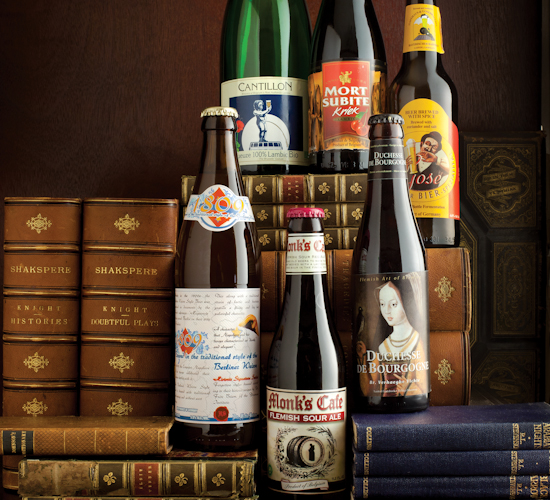American sour beers have spawned a movement, with sour festivals like What the Funk?! and Night of the Funk driving proclamations that sours are “the next big thing.” They may not sound appealing to newcomers, with their enamel-scraping sourness and flavor descriptors that span “cheesy” to “horseblanket.” These puckering beers get their wild, sour and funky flavors from specialty yeast and bacteria (the good kind!). For example, Belgian lambics famously ferment out in the open, picking up microorganisms like free-floating Lactobacillus bacteria and Brettanomyces yeast that land in the beer and produce the desired sour and funk. Today, breweries procure these microorganisms and inoculate their beer to achieve similar characteristics.
But Belgian and German brewers have brewed these niche beers for centuries; Germany’s Berliner weisse, for example, dates back to the Middle Ages. Taste these Old World examples to better understand craft beer’s hottest trend.
Gueuze
This blend of young and old lambics (spontaneously fermented ales from Belgium’s Senne Valley) is one of the Old World’s funkiest, tartest beers. Cantillon makes the most sought-after version: Classic Gueuze, a tart sipper laced with hay, citrus and funk.
Gose
The near-forgotten gose (pronounced GO-zuh), a low-alcohol, tart style brewed with salt and coriander, is fast becoming craft beer’s next big hit, but it all started in 18th-century Leipzig, Germany. Gosebrauerei Bayerischer Bahnhof has carried tradition in that very town since 2000: Its Leipziger Gose, which propels subtle saline, herbs and a sour snap across the tongue, brought this style mainstream.
Berliner weisse
Berliner weisses were all but extinct, until Professor Fritz Briem, tech director of Germany’s Doemens Institute beer academy, began bottling his 1809 in 2006, bringing back the classically easy-drinking style that balances sunny lemon with clean, yogurty tartness.
Kriek
Lambics hail from Belgium and can be spiked with a variety of fruit, but the cherry-infused versions, called krieks, are worldwide favorites. Mort Subite Kriek explodes with bright tart cherry and playful pucker: Because it’s brewed with real fruit, the sweet-and-sour sensation is intense.
Flanders red ale
Duchesse de Bourgogne—known to the initiated as simply Duchesse—carries the torch for this funky, fruity Flemish style, and it’s the flagship beer of the 130-year-old Verhaeghe Brewery. True to style, Duchesse floods
the taste buds with layers of rich dark cherries and currants, backed by a rustic, sour bite.
Flanders brown ale
Darker baritone siblings of higher-pitched Flanders reds, Flanders browns (a.k.a. oud bruins) pair cola, molasses and plum notes with vinegary tartness. Monk’s Café Flemish Sour Ale, brewed by Belgium’s Van Steenberge for the famed Philly mussel spot, is one of our nation’s only widespread versions.










